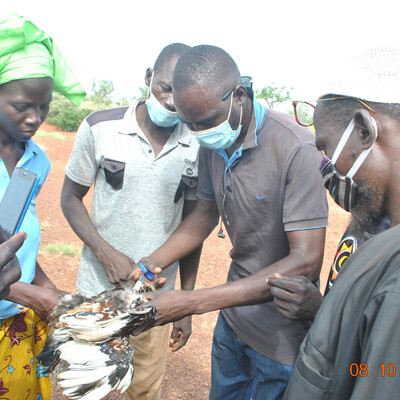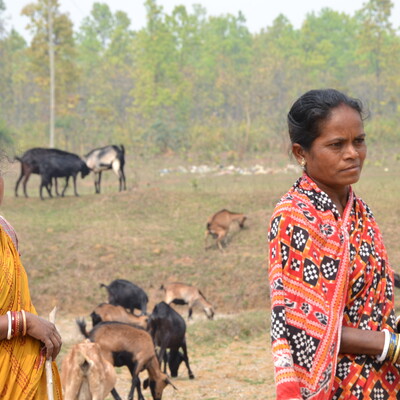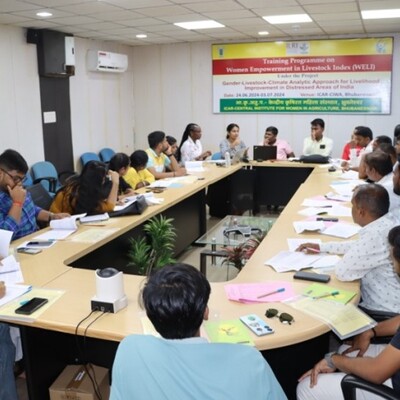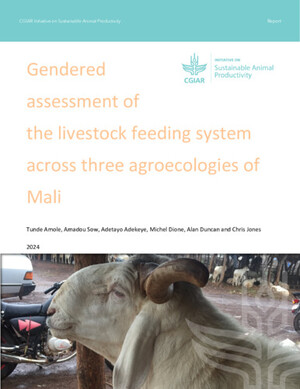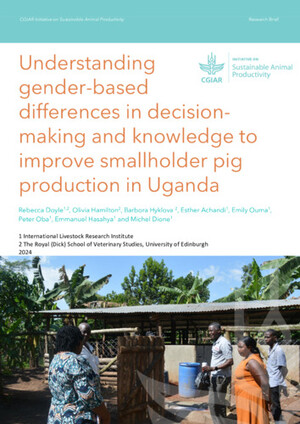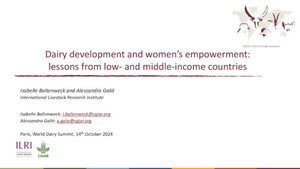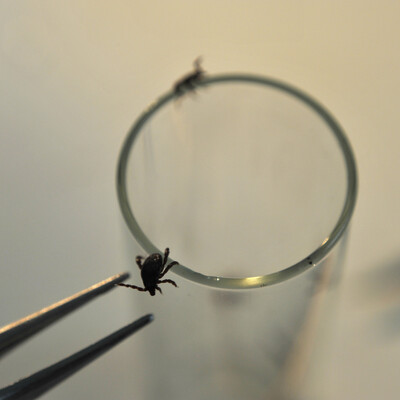
Meet scientists in ILRI’s Livelihoods, Gender and Impact Program: Elizabeth Waithanji
In the run up to the International Women’s Day commemorated on 8th March 2014, each week on this blog we will meet gender scientists working in the Livelihoods, Gender, Impact and Innovations Program at ILRI. This week, we meet Elizabeth Waithanji a gender scientists who worked with the program for four years until October 2013. Waithanji points out that ‘the gender strategies within the CGIAR research programs have been well thought out and deserve to be mainstreamed in projects and programs’
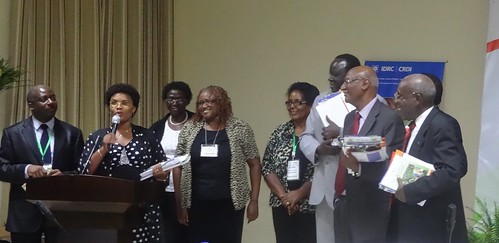
Elizabeth Waithanji (4th from left) looks on as Odette Kayitesi, Burundi minister of agriculture and livestock officiates at the launch of the ILRI-IDRC book on ‘Women, Livestock Ownership and Markets’ during the 2nd Association for Strengthening Agricultural Research in Eastern and Central Africa (ASARECA) general assembly, 9-13 December 2013, in Bujumbura (photo credit: ILRI/Evelyn Katingi)
How did you develop interest in gender research?
I started as a trained veterinarian teaching large animal surgery at the Kabete veterinary school of the University of Nairobi. As part of the university staff development program, I got an opportunity to study camel trypanosomiasis in Marsabit, Kenya, and was attached to Farm Africa, which had development projects in the district. That was my first exposure to development work. During my experience doing development work, in Marsabit and later in other places, I realized that even with my knowledge in clinical veterinary medicine, I was not adequately equipped to understand and contribute appropriately to ways of address the development issues challenging the communities that I worked with. I realized that among these pastoral communities were many challenges such as water and pasture shortages and conflicts over these resources. I realized that in addition to my technical skills, I needed to have some skills in addressing the social issues if I was going to become more relevant in terms of helping improve the livelihoods of vulnerable people living in marginal areas. As a result, I developed an interest in natural resource management because most of the conflicts among these marginal communities were over water and pasture. I also developed an interest in policies – more specifically, the political economy of places and the policies on distribution and use of natural resources. More specifically, I purposed to know what policies aggravate tensions, and which ones reduce tensions. At the macro level, therefore, I became interested in policies and at the micro level, and especially at the in the household and community level, I started paying attention to relations of power among different gender and socio-economic categories of people, such as women, men and the youth, and the rich and poor. At this point, I decided to pursue a PhD in human geography, specifically on political economy focusing on gender, natural resources and livelihoods.
What has been your experience as a gender scientist in relation to your work and the situation in the agricultural and livestock sector?
It has been exciting and very challenging especially because a lot of things have not been explored exhaustively. It is like being thrown in a jungle and then trying to establish in there. One’s first experience in the development work-world can be overwhelming and one has to really focus on a certain area. In the area of gender and development too, many things that need to be addressed have not been addressed. I found the opportunities exciting and the work overwhelming because I could not do everything at once. I decided to focus on what I can do best and chip at it a piece at a time, something that has now become my work philosophy. Gender and livestock was a really good entry point in my post PhD research career because I understand the livestock issues from a clinical and social dimension owing to my training as veterinarian, experience working with livestock dependent marginal communities and my training as resource, gender and livelihoods human geographer.
You say that a lot has not been explored and addressed in relation to gender research and development issues; in your opinion, why is that?
Gender is a fairly new area of research inquiry compared to other areas such as veterinary medicine. Gender issues have existed for as long as people have existed for example as highlighted in Virginia Woolf’s “A Room of One’s Own”, and before, attention to gender in development was brought about by fairly recent works like Esther Boserup’s 1970’s book “Woman’s Role in Economic Development”. However, gender has never been systematically addressed. Maybe it is because gender is about constantly contested power relations between men and women whereby the contestations are embedded in the very process of inquiry and implementation of change. For example, much resistance to change advocated for in gender interventions can be associated with the historical and cultural subservience of women, which is maintained as cultural gender norms and roles and supported and disseminated down generations in discourse, speech and song. These inequalities of power have resulted to the differences we see between men and women. If you are trying to address that, then you are trying to change power relations and changing power relations means that the powerful have to relinquish some of the power to the powerless and that is always a very big struggle. Because of the nature of gender relations, addressing it as a subject of inquiry is easier than implementing activities that will change the inequalities stemming from the socially constructed identities of men and women and boys and girls.
As much as you mention that a lot of issues have not yet been addressed, what progress would you say has been made?
A lot of progress has been made to demonstrate the differences. For example, gender inequalities in organizations can be demonstrated by the ratio of men and women in senior management, but counting heads and just showing that, yes, there is a difference here does not fix this problem. Another example is that certain jobs are known to be women’s jobs and others men’s jobs, but when women jobs become lucrative, men get into those jobs like hairdressers, cooks, nurses among others. There is a shift whereby when things become attractive in the women’s domain, the men take over. The two genders are, therefore, not equal. What I believe has not been done is to stop these things from happening, which is still a big area of struggle. In Gender Transformative Approaches (GTAs), pro change actors attempt to address these inequalities in ways that will change them permanently and sustainably. Often, agents of change experience backlash which is a form of violence against the agent and can range from physical violence to social stigma. An example of backlash is domestic violence towards women who question oppressive tendencies by their spouses. Backlash acts as a deterrent for the powerless from trying to take back the power that is rightfully theirs. I believe that the biggest challenge experienced by gender practitioners is how to overcome this power struggle, how to bring about a gender power balance without the backlash.
Do you think a critical mass has been reached in terms of the gender practitioners?
No – there is a big shortage; there are many ‘number counters’ but the critical analysts are not enough. Many gender practitioners lack the political will to address GTAs; somebody has to get in there, experiment, and if it backfires it might ruin your career. Who wants to take such a risk? Nobody wants to cause more problems to people and few people will take the risk. Others lack the capacity to identify what needs to be done and how it gets done to make a difference. There are so many problems in this world, that sometimes, it is better to address the problems that are easier to solve, what I call ‘low hanging fruits’. For example if the women have been denied access to the forests by men and they are not able to get firewood, you come in and get the women some solar stoves, which do not use firewood. That way, you have steered clear of the forest issue and the conflict it would have caused, and the women will achieve what they want. Many gender programs go around gender problems this way and do not transform the relations of power.
Having worked in this field and specifically with the LGII program for close to four years; what do you consider as some of your major highlights?
My research has been two-fold:
• Strategic gender research
This involves carrying out small-scale studies on issues that have not been explored, to understand the problem better, I call it testing concepts. I try to understand the differences in gender. For example, on market participation; why are women concentrated in the farm gate markets, whereas the men sell to all the markets and are able to reach even the foreign market – I try to understand this situation and the difference so that I can apply the lessons learned from this small-scale research in larger scale research projects such as value chain interventions. Larger project actors consider the lessons and advice given from the recommendations of this study and implement them. For example, special affirmative actions and opportunities that can enable women to participate in markets beyond the farm gate, while still safeguarding the relationships between men and women. They may include making the farm gate market more lucrative.
• Mainstreaming gender research by integrating lessons learnt from the strategic gender research
An example of mainstreaming gender research can be demonstrated in the implementation of gender strategies in core research projects. Although gender strategies have been developed and published, their mainstreaming is yet to be demonstrated. At this point, it is difficult to tell what is happening in all projects, but my experience points to the reality that the reception and integration of these strategies varies with projects, with some projects embracing them and running with them and others ignoring them or dismissing them as too much work with the possibility that integrating gender will make no difference in the results. Either of these reactions is to be expected as different program leaders and actors have different understandings of gender and their political will varies. My parting shot to all, as I leave LGII, is that it is always better to try something and demonstrate that trying it was a waste of time than not trying because trying it might be a waste of time. The gender strategies have been well thought out and deserve to be mainstreamed in projects and programs.
Elizabeth Waithanji holds PhD and MA in Geography, an MSc in Clinical Studies and a Bachelor of Veterinary Medicine (BVM). Her current work, located in Africa and Asia, focuses on understanding gender in terms of measuring empowerment and gender empowerment gaps as well as assets and gender asset gaps in order to inform projects that target the narrowing of these gaps; looking at the roles of men and women in livestock value chains and how gender influences these roles and men and women’s ability to build and own assets. Other areas of research focus include gendered analyses of livestock value chains, and inter- and intra-household asset disparities in livestock and food crop production, disparities in market and technology access and decision making within the household. Past work includes a study on mobility and gender relations after sedentarization among Somali nomads of northeastern Kenya and ethnography on gender struggles in development interventions among the Somali of Gedo in southern Somalia. Findings on most of these studies have been published in academic journals, research/policy briefs, chapters in books and have been presented in multiple conferences. Her most recent publication (2013) includes Gendered Participation in Livestock Markets. Chapter In Women, livestock ownership and markets: Bridging the gender gap in eastern and southern Africa






